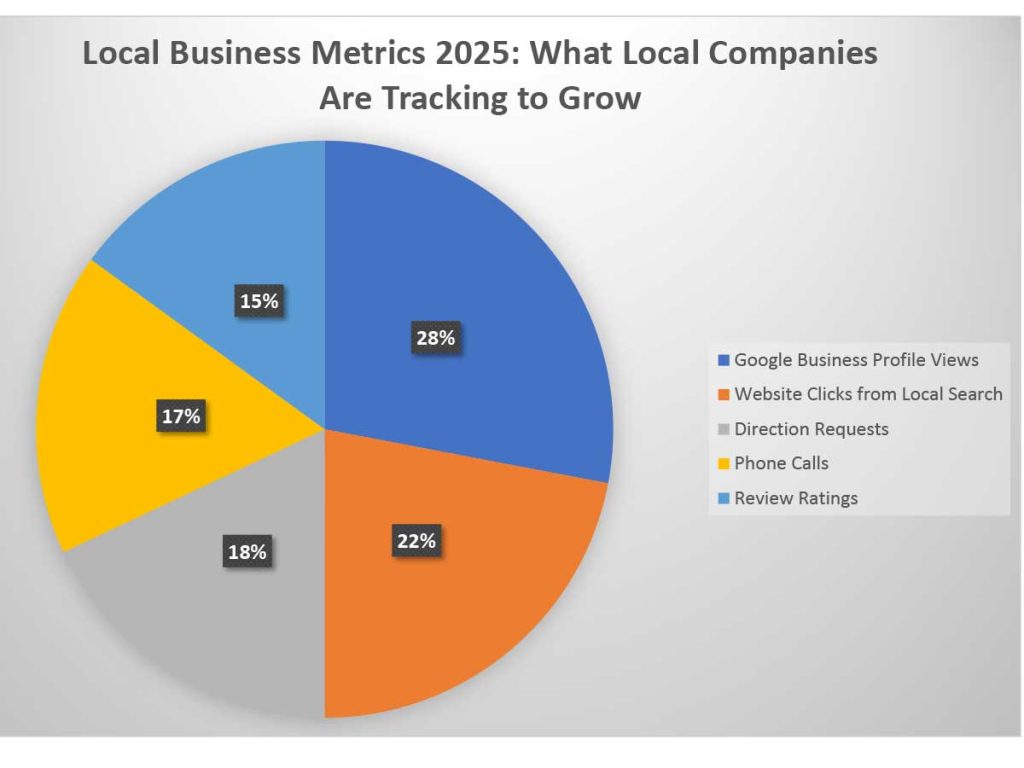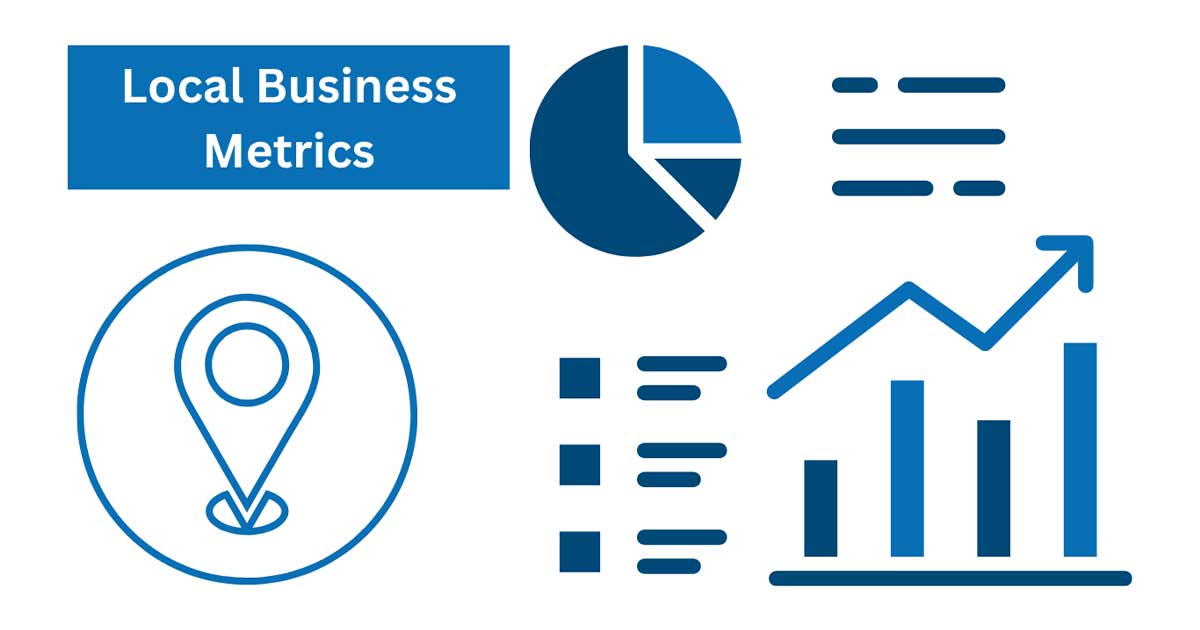What do local business metrics truly tell you about how well your business is doing in your area?
It’s not enough to only sell good goods or services to run a business in your area. It’s also about knowing how well you’re reaching clients, keeping them pleased, and remaining one step ahead of the competition in your area.
Local Business Metrics are the figures and data points that reflect how well your business is doing in important areas like foot traffic, customer reviews, website traffic, and Google rankings. These numbers tell you what’s working and what needs to be fixed, so you can make better choices.
This blog is all about local business metrics. We’ll go over the most crucial ones to keep an eye on and how they might help you grow in 2025. It’s a good idea to keep an eye on these numbers, whether you’re just starting out or trying to get better.
Key Takeaways
- Looking back at marketing returns on investment helps allocate resources wisely. This ensures that growth is sustainable in the long run.
- MRR, CLV, and CAC show how well the business is doing and if it is making profits.
- NPS and conversion rates tell us how happy customers are and how our marketing is working.
- Website and social media analytics show us how visible we are online. Customer behavior and interactions on those channels give us insights into engagement levels.
How to Understand Local Business Metrics and Growth KPIs
Business metrics and growth KPIs are like a compass that shows your organization the way to success. These measurable metrics help you keep track of, analyze, and improve many parts of your business’s performance.
What Are Metrics for Business?
Business metrics are precise pieces of information that show how well your business is doing in different areas. They give you information about how your business is running, which helps you figure out what’s working and what needs to be improved. Think of these as important indications that show how well your firm is doing. This insight is clearly reflected in Local Business Metrics
Getting to Know Growth KPIs
Growth KPIs, or Key Performance Indicators, are special measurements that are only used to measure and track business growth. These indicators let you keep track of how close you are to reaching your strategic goals and make choices based on data that will help your business grow in a way that lasts.
The Strategic Worth
When done correctly, these metrics have a number of benefits:
- A clear view of how well the firm is doing
- Signs that anything might go wrong early on
- The ability to make decisions based on data
- Fairly judging methods
- Better use of resources
What makes metrics useful
The most useful measures have three important traits in common:
- Able to be measured and counted
- Directly linked to business goals
- Set a time limit and keep track of it
- Useful and easy to act on
- Important to your field
The Growth Metric Framework
A strong framework for measuring growth usually includes:
- Indicators of money
- Metrics for customers
- Efficiency in operations
- How well the market does
- How productive employees are
What is the difference between metrics and KPIs?
Metrics are numbers that show how well your firm is doing in certain areas, while KPIs (Key Performance Indicators) are strategic metrics that are directly related to your business goals. You can think of metrics as separate jigsaw pieces and KPIs as the important corner pieces that make up the picture of your firm. This insight is clearly reflected in Local Business Metrics
Indicators that lead and those that lag
Leading indicators let you guess how something will do in the future. For example, internet traffic can help you guess how many sales you might make. On the other hand, lagging metrics look at historical results, like monthly sales or revenue.
Value in Strategy
Not all metrics are KPIs, but all KPIs are metrics. A key statistic becomes a KPI when it is directly related to your business goals and gives you useful information for making decisions. For example, the number of people who follow you on social media could be a statistic, but the conversion rate from social media could be a KPI if social selling is a key part of your business.
Why Keep an Eye on Business Metrics?
It’s not enough to just collect figures when you track business metrics. You also need to comprehend how the whole organization is growing and make decisions based on facts. Businesses may learn a lot about how well they are doing, find ways to improve, and stay ahead of market trends by keeping an eye on key metrics. Local Business Metrics help support this observation
Making decisions that are good for business
Metrics give you hard proof of what is and isn’t working in your business. You don’t have to rely on gut feelings; you can make smart choices based on genuine evidence. This method helps them figure out how well their marketing is working and makes sure that resources are used wisely.
Finding problems early
Tracking metrics on a regular basis can help you see problems in your business’s environment before they happen. You can fix things before they get worse if you see patterns that are going down or changes that you didn’t expect. It aligns well with Local Business Metrics
Opportunities for Growth
Metrics show you what your firm is doing well and where it could do better. This information lets you:
- Find tactics that work and are worth scaling
- Find regions that aren’t doing well and need help
- Find innovative ways to grow your business
- Keep an eye on how well you’re doing towards your business goals
Communication with Stakeholders
It is simpler to tell people about how well a firm is doing when you have real numbers to back it up.
- Investors
- Members of the board
- Members of the team
- Friends
This openness develops trust and makes sure that everyone knows where the firm is going and how far it has come.
Why Local Business Metrics 2025 Are More Important Than Ever for Growth
How can you be sure that your small business is growing and not just keeping busy?
Local Business Metrics 2025 tells you more about your small business growth.
It shows how many customers Google found, how many reviewed, and how many came back. These data were helpful in figuring out the strong sides and weaknesses. They give insights into how to beat the competitors.
In short, Local Business Metrics 2025 is a good tool for owners to understand performance, satisfy customers, and grow competently.
| Name of the Metric | What It Measures | Why It Matters in 2025 |
|---|---|---|
| Google Profile Views | How often your business shows up in search/maps | Shows your visibility in local search |
| Click-to-Call Rate | How many people call directly from your listing | Measures real customer interest |
| Direction Requests | How many people enquire for directions | Shows how many people are walking by and how appealing the location is |
| Review Count & Ratings | Total number and quality of reviews | Builds trust and boosts your search ranking |
| Customer Return Rate | How many customers come back | Helps measure loyalty and satisfaction |
| Social Media Engagement | Likes, comments, and shares on posts | Shows how well your content connects locally |
Are you keeping an eye on the right Local Business Metrics in 2025?
Have you ever thought about how some businesses in your area appear to get more clients while others don’t?
Local Business Metrics 2025 is a list of the most important figures that local businesses use to see how well they’re doing. These include how often people find them online, how many people phone, click, or visit, and what kind of evaluations they get. These numbers tell you what is working and what needs to be better in your marketing and customer service.
This pie chart shows the top Local Business Metrics 2025 that businesses are paying the most attention to. It shows you what matters in today’s digital-first local economy and tells you where to put your energy.

Important metrics for financial growth
Financial metrics are the most important part of your business growth strategy since they give you important information about how well your company is doing financially. These numbers help you make judgments based on facts and find ways to do better. It aligns well with Local Business Metrics
Local Business Metrics for Revenue
Tracking monthly and yearly income is the basis of financial analysis. Your total monthly revenue can help you spot short-term trends, and your annual returning revenue can provide you with a bigger picture of how your business grows over the course of a year. You can do the following by keeping an eye on these metrics:
- See changes in the seasons
- Find out if revenue is going up or down
- Make good guesses about how much money you’ll make
- Change your pricing strategy in a smart way
Local Business Metrics Margins of Profit
To build your business in a way that lasts, you need to know your profit margins. Keep an eye on both gross and net profit margins to:
- Check how well the prices work
- Keep operational costs in check
- Check how well you do versus industry standards
- Choose investments wisely
Local Business Metrics Looking at cash flow
For a business to last, it is important to keep a strong cash flow. Watch:
- Cash flow from operations
- Cash flow that is free
- Cycle of cash conversion
- Ratio of working capital
Local Business Metrics Indicators of Growth Rate
Keep an eye on growth rates from year to year in a number of areas:
- Rate of growth in revenue
- Growing the customer base
- More market share
- Rate of increase of assets
Local Business Metrics Managing Expenses
To stay profitable, keep a tight check on your spending metrics:
- Ratio of operating costs
- Cost of goods sold (COGS)
- Costs of running the business
- Costs that change
Keep in mind that you need to look at these numbers in light of your business goals and the standards in your field. Regular monitoring helps you spot trends early and change your financial plan as needed. These outcomes are tracked through Local Business Metrics
(Key takeaway: Key financial growth measures give you a complete picture of your business‘s financial health, which helps you make smart decisions that will help it develop in a sustainable way.)
Monthly Revenue That Happens Again
Monthly recurring revenue (MRR) is a key growth statistic that helps firms figure out how much money they will make in the future. It shows how much money a business expects to make each month from its regular clients.
How to Figure Out MRR
Just take the total number of paying customers and multiply it by the average revenue per user (ARPU). If you had 100 customers who each paid $50 a month, your MRR would be $5,000.
Why MRR is Important
MRR gives you useful information on the financial health and growth path of your business. It helps you:
- Make better predictions about future sales
- Make smart choices on how to use your resources
- Keep track of how the business grows each month
- Find patterns in revenue that happen at certain times of the year
- Make plans for expanding your business
How to Raise MRR
- Keep your customers by focusing on keeping them.
- Use strategic upselling to boost ARPU
- Cut down on churn by offering proactive client service
- Give people reasons to make long-term commitments
- Keeping an eye on price strategies on a regular basis

Local Business Metrics Value of a Customer’s Lifetime
The customer lifetime value (CLV) statistic shows organizations how much money they can expect to make from a single customer over the course of their whole relationship. It’s a forward-looking indicator that shows how the firm will grow in the future and helps you make smart choices about getting and keeping customers.Such patterns are visible in Local Business Metrics
To figure out CLV, you need to look at the average revenue per customer, how often they buy from you, and how long you expect the customer relationship to last. Businesses can better use their resources and focus on high-value client segments if they know what these parts are. Local Business Metrics provide context for this trend
- Important Parts of CLV
- Average value of a purchase
- Rate of purchases
- Length of the customer connection
- Profit margin for each customer
A greater CLV means better long-term business health and stronger relationships with customers. It helps organizations figure out which groups of customers are the most important and should get more attention and resources. Such patterns are visible in Local Business Metrics
How to Make CLV Better
- Improve the quality of customer service
- Start loyalty programs
- Make each customer’s experience unique
- Give yourself more chances to cross-sell
- Focus on ways to keep customers
Local Business Metrics Cost of Acquisition New Customers
The cost of getting new clients is an important number that has a direct effect on how much money your organization makes. It helps you figure out how much you’re spending on marketing to get each new customer. Such patterns are visible in Local Business Metrics
How to Figure Out CAC
Just take the overall cost of your marketing and sales and divide it by the number of new consumers you got in a certain amount of time. For example, if you spent $5,000 on marketing and got 100 new customers, your CAC would be $50 for each new customer. Local Business Metrics provide context for this trend
Why CAC is Important
Knowing your CAC can help you get the most out of your marketing budget and have a better return on investment. A lower CAC means that your marketing is working well, while a higher one means that you need to change your strategy. To see how well you’re doing, compare your CAC to industry standards.
Ways to Lower CAC
Focus on marketing strategies that are aimed at specific groups
- Make your sales funnel better
- Use customer referrals
- Raise the rate of conversions
- Try out different ways to market
Keep in mind that you should look at CAC along with other metrics, such as Customer Lifetime Value, to make sure your acquisition costs are low enough for long-term growth.

Local Business Score for Net Promoter
Net Promoter Score (NPS) is a great way to find out how loyal and happy your customers are. It does this by asking them one easy question: “How likely are you to recommend our business to others?” This measure gives you useful information about how your customers feel overall. Such patterns are visible in Local Business Metrics
How NPS Works
The grading system goes from 0 to 10 and puts clients into three groups:
- Promoters (9–10): Loyal fans who help the business expand
- Passives (7–8): Customers who are happy but not excited
- Detractors (0–6): Unhappy customers who can hurt the brand’s reputation
Finding NPS
To find your NPS, take the percentage of promoters and subtract the percentage of detractors. Your NPS would be 50 if 60% of people are promoters and 10% are critics.
Why NPS is important
NPS is intimately linked to business growth because:
- It can tell how customers will act and how loyal they will be.
- Helps find areas that need to be better
- Gives feedback that can be used to make customers happier
- Makes it possible to compare with industry standards
A high NPS means that you have good relationships with your customers and that word-of-mouth marketing could help your business develop naturally.
Local Business Metrics for keeping and engaging customers
Customer engagement and retention are two of the most important things that businesses need to do to thrive over time. These numbers show you how well your firm remains in touch with current consumers and gets them to come back for more. Such patterns are visible in Local Business Metrics
Rate of Customer Churn
The customer churn rate tells you what proportion of customers stop doing business with you over a certain period of time. If a lot of people leave your business, it could mean that something is wrong with your product, service, or customer experience. To figure it out, divide the number of customers who left by the total number of customers at the start of the term. Local Business Metrics provide context for this trend
For instance, if you had 1000 clients and lost 50 in a month, your monthly churn rate would be 5%. According to industry standards, a healthy churn rate should stay below 5–7% each year.
Rate of Keeping Customers
This number is the opposite of churn; it tells you how many consumers stay with your business. High retention rates are a sign that customers are happy and loyal. Figure it out by:
- Counting the number of customers at the end of a period
- Taking away new clients gained during that time
- Dividing by the number of customers at the beginning
100 times Customer Engagement Score
A full engagement score takes into account many things:
- How often do you buy
- How long do people spend on your website or app
- Interacting with marketing messages
- Getting people to use social media
- Interactions with customer service
Local Business Metrics for Active Users
To see how people use your site, keep track of your daily, weekly, and monthly active users (DAU, WAU, and MAU). The stickiness ratio, which is the ratio of these two numbers, shows how often customers interact with your business. Local Business Metrics provide context for this trend
Metrics for Customer Feedback
Keep an eye on how happy your customers are by:
- Times for resolving support tickets
- Scores for customer satisfaction (CSAT)
- Ratings for product reviews
How to Figure Out the Conversion Rate
To find the conversion rate, divide the number of conversions (desired actions done) by the total number of visits or leads, and then multiply by 100. If 100 people go to your website and 5 of them buy something, your conversion rate is 5%. Local Business Metrics provide context for this trend
Important Conversion Points to Keep an Eye On
- From the landing page to the lead form
- Sign up for email to make your first purchase
- Free trial before paying for a subscription
- From the shopping cart to the checkout
- Click-through from social media to website
Standards in the industry
The average conversion rate in most industries is between 2% and 5%. But the best organizations often get rates of 10% or greater by using the best marketing methods and making sure that users have a smooth experience.
How to Raise Your Conversion Rate
Use these tried-and-true methods:
- Make your checkout procedure easier
- Make calls to action that are interesting
- Speed up the loading of pages
- Test different parts of your landing page with A/B testing
- Use trust cues like reviews
Give explicit reasons why your offer is valuable
By checking your conversion rates often with marketing reports, you can find problems and chances to make things better. You can make better decisions on how to get new clients by regularly looking at this metric.
What people are saying on social media
Regularly looking at these measures for engagement and retention will help you spot patterns and take steps to strengthen client connections and keep revenue from falling. Local Business Metrics provide context for this trend Looking at the conversion rate
The conversion rate analysis is an important number that shows how well your firm turns potential leads into paying clients. It helps you figure out how well your marketing is working and where you can make your sales funnel better.
How well does your website and social media work
Website analytics and social media platforms give you important information about how people interact with your business online. These numbers show you how well your digital marketing is reaching and connecting with the people you want to reach. Local Business Metrics provide context for this trend
Important Social Media Metrics to Keep an Eye On
- Follower Growth Rate: Keep an eye on how quickly your social media following grows.
- Engagement Rate: Compare the number of likes, comments, and shares you get to the number of followers you have.
- Post Reach: Find out how many different people see your material.
- Click-Through Rate: Keep an eye on how often people click on the links you share.
Important Website Analytics
- Average Time on Site: Find out how long people stay on your site and read your content.
- Bounce Rate: Keep track of how many people leave after just seeing one page.
- Page Views per Session: Find out how many pages users look at throughout each visit.
Mobile vs. Desktop Usage: Look at how people get to your site
You can learn a lot about how people use your site by using Google Analytics and visitor queue tools. These platforms give you useful information on where traffic comes from, what content is popular, and how users move across your site.
Keep in mind that you should look at these numbers in light of your business goals. A single-page website might be okay with a high bounce rate, but an e-commerce site might have trouble with one.
Set up personalized dashboards in your analytics tools to keep an eye on the indicators that matter most to your organization. This makes your analysis easier and helps you find trends or problems more quickly.
The main point is that using tools like Google Analytics to keep an eye on how well your social media and website are doing will help you increase your online presence and get more people to interact with you.
Local Business Metrics for marketing performance
Marketing performance metrics are important tools that firms use to see how well their marketing efforts and campaigns are working. These indicators show you how effectively your marketing techniques are working and where you can make them better. Local Business Metrics provide context for this trend
Local Business Metrics for Lead Generation
It’s important to know how well your marketing activities bring in new leads. Keep an eye on numbers like:
- Score for lead quality
- The time it takes to respond to a lead
- Assigning leads to their sources
- Price per lead
- Ratio of leads to opportunities
Indicators of Campaign Performance
Your marketing team should keep a careful eye on how well campaigns are doing by:
- The rates at which people open and click on emails
- Conversion rates for landing pages
- Rates of interaction on social media
- Performance of pay-per-click (PPC)
- Metrics for content marketing
Analytics for Digital Marketing
Use marketing tools like Google Analytics to keep track of:
- Where the website traffic comes from
- Flow of user behavior
- Rates of bounce
- Average length of a session
- Rates of completing goals
Local Business Metrics for Brand Awareness
Keep an eye on your brand’s growth and presence in the market by:
- Share of voice
- How often the brand is mentioned
- Growth in the number of people who follow you on social media
- Metrics for press coverage
Analyzing how people feel about a brand
Make sure these KPIs are in line with your overall business goals and go over them with your marketing staff on a regular basis. Use technologies that help you see data to make full marketing reports that indicate how your marketing has worked. Local Business Metrics provide context for this trend
(Key takeaway: Marketing performance metrics give you a complete way to judge how well your marketing is working, so you can make data-driven decisions and make strategic adjustments across all marketing channels.)
Return on Investment in Marketing
Marketing organizations may justify their spending and make the most use of their resources by measuring marketing ROI. Think about:
- Cost per acquisition
- The ratio of customer lifetime value to CAC
- MQLs (marketing qualified leads)
- Leads that are qualified for sales (SQLs)
- Channel-based revenue attribution
Measuring ROI
To see how well your marketing and business plans are working, you need to measure your return on investment (ROI). It helps you figure out which activities make the best use of your company’s resources.
Basic ROI Calculation
It’s easy to figure out ROI with this math formula:
- ROI = (Net Profit / Total Investment) x 100
- Net Profit = Total Revenue minus Total Costs
All costs, such as marketing, operational, and overhead expenditures, are included in the total investment.
More advanced ROI factors
To get an appropriate ROI measurement, think about these things:
- Length of time for measurement
- Costs that are direct and indirect
- Returns over the long term vs. the near term
- Conditions in the market and outside forces
- Timeline for getting new customers
ROI Benchmarks for Each Industry
Different industries have different expectations for ROI:
- E-commerce: 300–500%
- Digital Marketing 200–350%
- Content Marketing150–300%
- Marketing on Social Media 100–200%
- Email Marketing 400–600%
Mistakes that people often make while measuring ROI
To get the right ROI, don’t fall into these traps:
- Not paying attention to hidden costs
- Not taking into consideration the time spent
- Only looking at short-term results
- Not paying attention to the value of a customer over their lifetime
- Ignoring qualitative benefits
- Looking at old data
Historical data analysis is a very useful tool for making business decisions. Businesses can find patterns, trends, and seasonal changes in their growth by looking at prior performance measures.
Learning about patterns from the past
You can guess what will happen in the future by looking at a company’s past data for a certain amount of time. These patterns show which techniques worked, which didn’t, and what has to be changed. For example, looking at sales data from one year to the next can show how customer behavior changes over different times of the year.
Measuring Performance
Historical data gives us a starting point for judging how well things are going now. Companies can:
- Keep an eye on how close you are to your goals
- Find areas that need work
- Set goals that are reasonable based on what you’ve done in the past.
- Know how fast things are growing and how the market works
Making decisions based on data
When used with current metrics, historical analysis lets us:
- Better predictions
- Better use of resources
- Better handling of risks
Making plans based on patterns that have worked in the past
Best Ways to Do Historical Analysis on Local Business Metrics
- Use the same procedures to collect data every time
- Regularly clean and sort data
- Compare things over the right amount of time
- Think about outside things that could alter the data
- Write down important events or changes that affect metrics
Strategies for Tracking and Implementation
Setting up a strong tracking system for your business KPIs doesn’t have to be hard. Start by figuring out which indicators are most important for your business goals and growth goals. It aligns well with Local Business Metrics
How to Set Up Your Tracking Framework
Start with a clear plan that lists the metrics to keep an eye on, how often to check them, and who is in charge of doing so. As a private business owner, you should pay attention to measures that have a direct effect on your profits and growth potential. It aligns well with Local Business Metrics
Set up a time to look at your data on a regular basis: weekly for operational indicators and monthly for strategic ones. This methodical way of doing things helps you keep track of your progress.
Picking the Right Tools for Local Business Metrics
Choose tools that fit your business’s needs and budget. There are other metrics you can track, but start with these simple but effective platforms:
- Google Analytics to check how well your website is doing
- CRM systems to keep track of sales
- Tools for analysing social media
- Software for managing money
- Platforms for getting feedback from customers
Best Ways to Put into Action
- Start small and grow slowly.
- Make sure the data is correct and consistent.
- Teach your team how to collect data correctly.
- Set goals that are possible to reach
Check your metrics from time to time and change them as needed.
Making insights that can be used
By doing the following, you can turn raw data into useful insights:
- Finding patterns and trends
- Looking at how present performance stacks up against past performance
- Setting clear targets for improvement
- Making plans on how to respond to different situations
Keep in mind that tracking metrics isn’t just about gathering information; it’s also about using that information to make smart choices that help your organization thrive. It aligns well with Local Business Metrics
Regular monitoring helps this kind of business owner see how well their business is doing and make the changes that need to be made.
Key takeaway: To track metrics successfully, you need a disciplined methodology, the correct tools, and a promise to turn data into useful information that will help your organization thrive.
Tools for Keeping Track of Local Business Metrics
Choosing the correct tools to keep track of your business metrics is very important for keeping your data organized and accurate. Modern analytics platforms offer complete solutions that can turn raw data into useful information.
Tools for Analytics That Are Popular
Google Analytics is great for keeping track of how well your website is doing, how users are acting, and how many people are converting.
- HubSpot: Keeping track of all your marketing and sales metrics
- Salesforce: Advanced CRM metrics and managing customer data
- Mixpanel: Detailed data on how users interact with and engage with your site
- Tableau: Tableau has strong tools for visualizing and reporting data.
Important Things to Look For
- Keeping track of data in real time
- Dashboards that can be changed
- Reports that are done automatically
- The ability to work with other systems
- Access from mobile devices
- Options for exporting data
Choose tools that fit your business needs and budget, and don’t forget to do so. Start with simple tools and add more as your business grows.

Final Thoughts-Local Business Metrics
Local Business Metrics: Are you using the right metrics to see how your firm is performing?
Many business owners just focus on sales or social media likes, but there’s much more to track. By not looking deeper, you might miss growth opportunities or underlying issues.
Website visitors, Google reviews, local search rankings, and customer actions are all metrics that matter for local firms. These numbers show what’s working, what isn’t, and how to reach more people nearby.
Local Business metrics are key for making smart decisions and growing your firm in 2025 and later. By tracking and understanding these important numbers, you can better connect with your community, beat the competition, and keep your firm successful.

FAQs-Local Business Metrics
What are local business KPIs, and why should I care about them?
Local business metrics help you check how you are doing locally. You can track site visitors, calls, maps, and reviews. Use these numbers to see what works. Then you can get more local customers.
How might measurements from local businesses help my small business grow?
Pinterest board ideas show how customers interact and find you. Your marketing, focusing on effective measurements, will result in small growth and better decision-making.
What local business metrics should I keep an eye on?
Monitor your business metrics, such as views, calls, directions, website traffic, and reviews. Follow these leads to tell you how people discover and engage.
Where can I get information on local businesses for my shop or service?
From Google Business listing, Analytics, and social media checkups, local shops’ performance numbers. These tools are all I need for my local business.
How often should I look over the numbers for my local business?
Monthly is a good meeting time. Without ads or new campaigns, there is a need for weekly checking of specific values. Keeping up with such data helps me adjust quickly in my locality and stay alive.

